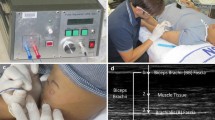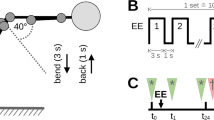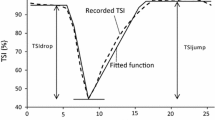Abstract
Mechanisms and structures which are involved in eccentric exercise-induced delayed onset muscle soreness (DOMS) are not yet clarified. Tissue and site specificity may be important considerations in afferent sensitisation following eccentric exercise. This study investigated the nociceptive response to hypertonic sodium solution applied to fascial/epimysium tissue and mechanically sensitised sites in muscle by assessing (1) afferent recordings in animals and (2) psychophysical assessment in humans. Seventeen male rats underwent eccentric contraction of extensor digitorum longus muscle, while 11 rats served as an unexercised naïve group. Two days post-exercise, group IV afferent fibre activity was recorded in response to superfusion of hypertonic Krebs solution on the mechanically sensitised muscle/epimysium site. Mechanical sensitisation was confirmed with significant increases in afferent response and decreases in threshold to mechanical stimulation in the eccentrically exercised rats compared to naïve rats. There was no difference in afferent response magnitude to hypertonic Krebs solution between exercise and naïve groups. In the human study, 13 volunteers participated. After bilateral assessment of pressure pain thresholds (PPT) along the tibialis anterior muscles, eccentric exercise was performed to induce DOMS in m. tibialis anterior of one leg. Site of maximal mechanical sensitivity was identified 24 h later and injected with hypertonic saline at fascial and deep muscle levels. The corresponding site on the opposite unexercised leg served as a control. Fascial injection of the exercised muscle caused significantly higher pain intensity compared to all other injections. Response to deep muscle stimulation was not different between sides. This suggests that fascia rather than muscle tissue is important in DOMS associated sensitisation.






Similar content being viewed by others
References
Andersen H, Arendt-Nielsen L, Danneskiold-Samsoe B, Graven-Nielsen T (2005) Muscle hardness and spatial pressure sensitivity in delayed onset muscle soreness. Program No. 454-P60. In: Abstracts 11th world congress on pain. IASP Press, Seattle, pp 174
Bajaj P, Graven-Nielsen T, Wright A, Davies II, Arendt-Nielsen L (2000) Muscle hyperalgesia in postexercise muscle soreness assessed by single and repetitive ultrasound stimuli. J Pain 1:111–121
Barlas P, Walsh DM, Baxter GD, Allen JM (2000) Delayed onset muscle soreness: effect of an ischaemic block upon mechanical allodynia in humans. Pain 87:221–225
Bennell K, Hodges P, Mellor R, Bexander C, Souvlis T (2004) The nature of anterior knee pain following injection of hypertonic saline into the infrapatellar fat pad. J Orthop Res 22:116–121
Birtles DB, Rayson MP, Jones DA, Padhiar N, Casey A, Newham DJ (2003) Effect of eccentric exercise on patients with chronic exertional compartment syndrome. Eur J Appl Physiol 88:565–571
Butterfield TA, Herzog W (2006) The magnitude of muscle strain does not influence serial sarcomere number adaptations following eccentric exercise. Pflugers Arch 451:688–700
Friden J, Lieber RL (1998) Segmental muscle fiber lesions after repetitive eccentric contractions. Cell Tissue Res 293:165–171
Friden J, Lieber RL (2001) Eccentric exercise-induced injuries to contractile and cytoskeletal muscle fibre components. Acta Physiol Scand 171:321–326
Gibson W, Arendt-Nielsen L, Graven-Nielsen T (2006) Delayed onset muscle soreness at tendon-bone junction and muscle tissue is associated with facilitated referred pain. Exp Brain Res 174(2):351–360
Graven-Nielsen T (2006) Fundamentals of muscle pain, referred pain, and deep tissue hyperalgesia. Scand J Rheumatol 35(122):1–43
Graven-Nielsen T, McCardle A, Phoenix J, Arendt-Nielsen A, Jensen TS, Jackson A, Edwards RHT (1997) In vivo model of muscle pain: quantification of intramuscular, electrical and pressure changes associated with saline muscle pain in humans. Pain 69:137–143
Graven-Nielsen T, Babenko V, Svensson P, Arendt-Nielsen L (1998) Experimentally induced muscle pain induces hypoalgesia in heterotopic deep tissues, but not in homotopic deep tissues. Brain Res 787:203–210
Graven-Nielsen T, Aspegren KS, Henriksson KG, Bengtsson M, Sorensen J, Johnson A, Gerdle B, Arendt-Nielsen L (2000) Ketamine reduces muscle pain, temporal summation, and referred pain in fibromyalgia patients. Pain 85:483–491
Hiyama TY, Watanabe E, Ono K, Inenaga K Tamkun MM, Yoshida S (2002) Na(x) channel involved in CNS sodium-level sensing. Nat Neurosci 5:511–512
Hodges PW, Moseley GL, Gabrielsson A, Gandevia SC (2003) Experimental muscle pain changes feedforward postural responses of the trunk muscles. Exp Brain Res 151:262–271
Hoheisel U, Mense S, Simons DG, Yu XM (1993) Appearance of new receptive fields in rat dorsal horn neurons following noxious stimulation of skeletal muscle: a model for referral of muscle pain? Neurosci Lett 153:9–12
Hoheisel U, Koch K, Mense S (1994) Functional reorganization in the rat dorsal horn during an experimental myositis. Pain 59:111–118
Hoheisel U, Unger T, Mense S (2005) Excitatory and modulatory effects of inflammatory cytokines and neurotrophins on mechanosensitive group IV muscle afferents in the rat. Pain 114:168–176
Itoh K, Kawakita K (2002) Effect of indomethacin on the development of eccentric exercise-induced localized sensitive region in the fascia of the rabbit. Jpn J Physiol 52:173–180
Itoh K, Okada K, Kawakita K (2004) A proposed experimental model of myofascial trigger points in human muscle after slow eccentric exercise. Acupunct Med 22:2–12
Kawakita K, Miura T, Iwase Y (1991) Deep pain measurement at tender points by pulse algometry with insulated needle electrodes. Pain 44:235–239
Kellgren JH (1938) Observations on referred pain arising from muscle. Clin Sci 3:175–190
Laursen RJ, Graven-Nielsen T, Jensen TS, Arendt-Nielsen L (1999) The effect of compression and regional anaesthetic block on referred pain intensity in humans. Pain 80:257–263
Lieber RL, Shah S, Friden J (2002) Cytoskeletal disruption after eccentric contraction-induced muscle injury. Clin Orthop Relat Res (403):S90–S99
Malm C, Sjodin B, Sjoberg B, Lenkei R, Renstrom P, Lundberg IE, Ekblom B (2004) Leukocytes, cytokines, growth factors and hormones in human skeletal muscle and blood after uphill or downhill running. J Physiol-Lond 556:983–1000
Morgan DL, Proske U (2004) Popping sarcomere hypothesis explains stretch-induced muscle damage. Clin Exp Pharmacol Physiol 31:541–545
Newham DJ (1988) The consequences of eccentric contractions and their relationship to delayed onset muscle pain. Eur J Appl Physiol Occup Physiol 57:353–359
Nie H, Kawczynski A, Madeleine P, Arendt-Nielsen L (2005) Delayed onset muscle soreness in neck/shoulder muscles. Eur J Pain 9:653–660
Prasartwuth O, Taylor JL, Gandevia SC (2005) Maximal force, voluntary activation and muscle soreness after eccentric damage to human elbow flexor muscles. J Physiol 567:337–348
Reeh PW (1986) Sensory receptors in mammalian skin in an in vitro preperation. Neurosci Lett 66:141–186
Saxton JM, Donnelly AE (1996) Length-specific impairment of skeletal muscle contractile function after eccentric muscle actions in man. Clin Sci 90:119–125
Schumacher MA, Jong BE, Frey SL, Sudanagunta SP, Capra NF, Levine JD (2000) The stretch-inactivated channel, a vanilloid receptor variant, is expressed in small-diameter sensory neurons in the rat. Neurosci Lett 287:215–218
Slater H, Arendt-Nielsen L, Wright A, Graven-Nielsen T (2003) Experimental deep tissue pain in wrist extensors: a model of lateral epicondylalgia. Eur J Pain 7:277–288
Slater H, Arendt-Nielsen L, Wright A, Graven-Nielsen T (2005) Sensory and motor effects of experimental muscle pain in patients with lateral epicondylalgia and controls with delayed onset muscle soreness. Pain 114:118–130
Taguchi T, Matsuda T, Tamura R, Sato J, Mizumura K (2005a) Muscular mechanical hyperalgesia revealed by behavioural pain test and c-Fos expression in the spinal dorsal horn after eccentric contraction in rats. J Physiol-Lond 564:259–268
Taguchi T, Sato J, Mizumura K (2005b) Augmented mechanical response of muscle thin-fiber sensory receptors recorded from rat muscle-nerve preparations in vitro after eccentric contraction. J Neurophysiol 94:2822–2831
Watanabe E, Fujikawa A, Matsunaga H, Yasoshima Y, Sako N, Yamomoto T (2000) Nav2/NaG channel is involved in control of salt-intake behavior in the CNS. J Neurosci 20:7743–7751
Weerakkody NS, Whitehead NR, Canny BJ, Gregory JE, Proske U (2001) Large-fiber mechanoreceptors contribute to muscle soreness after eccentric exercise. J Pain 2:209–219
Weerakkody NS, Percival P, Hickey MW, Morgan DL, Gregory JE, Canny BJ, Proske U (2003) Effects of local pressure and vibration on muscle pain from eccentric exercise and hypertonic saline. Pain 105:425–435
Whitehead NP, Weerakkody NS, Gregory JE, Morgan DL, Proske U (2001) Changes in passive tension of muscle in humans and animals after eccentric exercise. J Physiol-Lond 533:593–604
Woolf CJ, Salter MW (2000) Neuronal plasticity: increasing the gain in pain. Science 288:1765–1769
Yu JG, Thornell LE (2002) Desmin and actin alterations in human muscles affected by delayed onset muscle soreness: a high resolution immunocytochemical study. Histochem Cell Biol 118:171–179
Yu JG, Malm C, Thornell LE (2002) Eccentric contractions leading to DOMS do not cause loss of desmin nor fibre necrosis in human muscle. Histochem Cell Biol 118:29–34
Acknowledgments
The Danish Research Council supported this work.
Author information
Authors and Affiliations
Corresponding author
Rights and permissions
About this article
Cite this article
Gibson, W., Arendt-Nielsen, L., Taguchi, T. et al. Increased pain from muscle fascia following eccentric exercise: animal and human findings. Exp Brain Res 194, 299–308 (2009). https://doi.org/10.1007/s00221-008-1699-8
Received:
Accepted:
Published:
Issue Date:
DOI: https://doi.org/10.1007/s00221-008-1699-8




